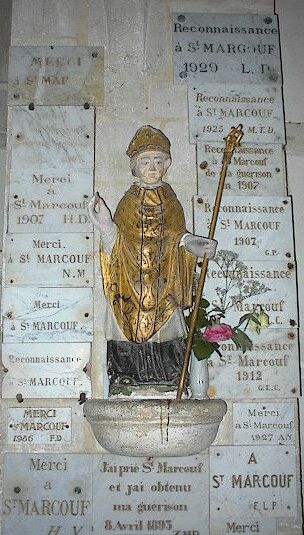
However, if you look on the map of mainland Normandy, you will not find Nanteuil marked - but off the East coast of the Cotentin you will find les îles St-Marcouf, and on the coast overlooking them a little way inland, a village called St. Marcouf de l'Isle. Here in effect is the ancient religious site of Nanteuil rechristened to mark the patronage of the evangelizer of the Cotentin.
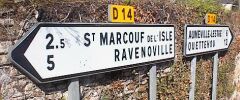
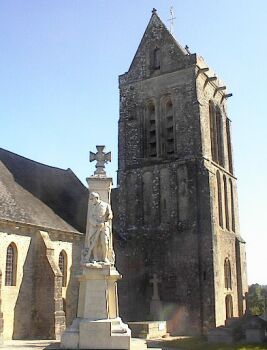
A prayer is available inside the church for those seeking healing:
|
Seigneur mon Dieu, je viens avec confiance me recommander à ton serviteur Saint Marcouf pour la guérison de mon corps et de mon âme. Je sais que tu m'aimes : ton Fils nous l'a montré en soulageant bien des miséres. Il est toujours vivant, spécialement dans la personne des saints. En son nom et par la prière de Saint Marcouf , je me confie à toi et te remercie pour le bien que tu peux me faire. Je te bénis pour toutes tes bontés , et pour te prouver ma reconnaissance je veux mettre plus de dévouement dans ma vie spécialement envers ceux qui souffrent. Notre Père ... Je vous salue Marie ... Saint Marcouf, priez pour nous!
|
The church is built on the site, the foundations even, of Marcouf's own monastery to which Helier came and spent some time in - as is recorded in a text displayed inside the church.
Visitors can descend to the crypt, which contains the oldest parts of the building - along with a much more recent seated statue of the saint.
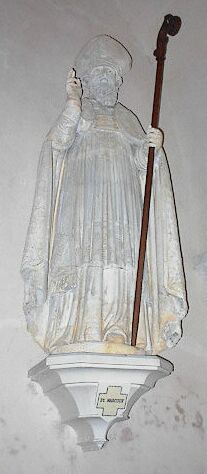
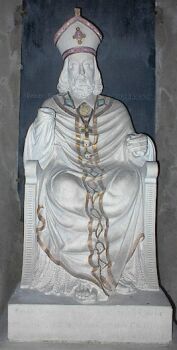
Up in the body of the church is a modern stained glass window depicting the saint.
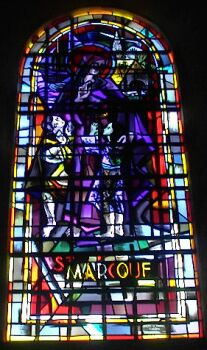
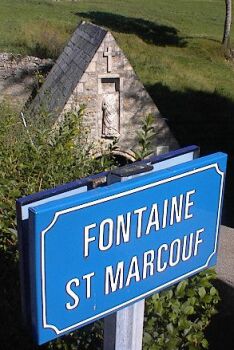
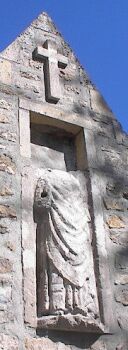
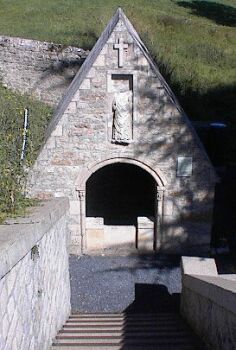
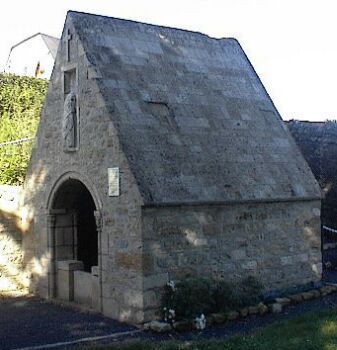
Among the interesting episodes in Jersey history are the ceremonies of Touching for the King's Evil carried out by Charles II while in exile in Jersey during the Civil War.
The pertinent point to note with regard to the story of Helier and Marcouf with regard to this event is that Kings of England and France claimed the power to Touch for the King's Evil (curing scrofula through the laying on of the Royal hands) through Saint Marcouf.
Marcouf's relics were venerated at his monastery in what was then Nanteuil, until raids on the area provoked their removal to a place of safety which turned out to be Corbény, near Reims. Reims being the traditional location for the coronation of French kings, the post-coronation pilgrimage to the miracle-working shrine of St. Marcouf seems to have endowed the kings with the reputation of partaking of the healing powers of the saint.
English kings who later claimed the French throne also ceremonially touched for the King's Evil. In an age of trial by ordeal, it was only logical that a demonstration of the healing power would bolster a king's, or a pretender's, claim to legitimacy.
Although French kings only claimed power to touch for the King's Evil after their coronation, English kings generally claimed the healing power from the moment of accession. Hence Charles's touching for the King's Evil in Jersey long before his formal Restoration - the public touching was an equally public claim of legitimate kingship affirmed by God, and powerful propaganda against the Commonwealth. He had been proclaimed king in Jersey, and touching for the King's Evil was one thing in his straitened circumstances which he could do that was incontrovertibly royal.
After Charles's death and the Glorious Revolution of 1688, the exiled Stuarts continued to touch for the King's Evil as a claim of status - as much as due to the fact of a steady stream of supplicants deprived of the hope of a miracle Royal cure since the Hanoverian monarchs declined to particpate in a ceremony they considered superstitious at best.
Although the legends of the saints' lives do not recount any miracle cures by Marcouf during his visits to Jersey, nor do we have healing springs attributed to our saints, by a quirk of history Marcouf's healing powers were indirectly invoked by the exiled Charles II.
On the frontage of a house in a backstreet not far from Bayeux Cathedral is a small statue and a plaque to mark Marcouf's birthplace:
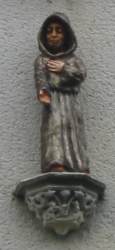

Viyiz étout:
Refs:
K. Thomas, Religion and the Decline of Magic, 1971
H. Gancel, Les Saints qui guérissent en Normandie, 1999

R'tou à la page d'siez-mé | Back to home page
E-mail: geraint@societe-jersiaise.org